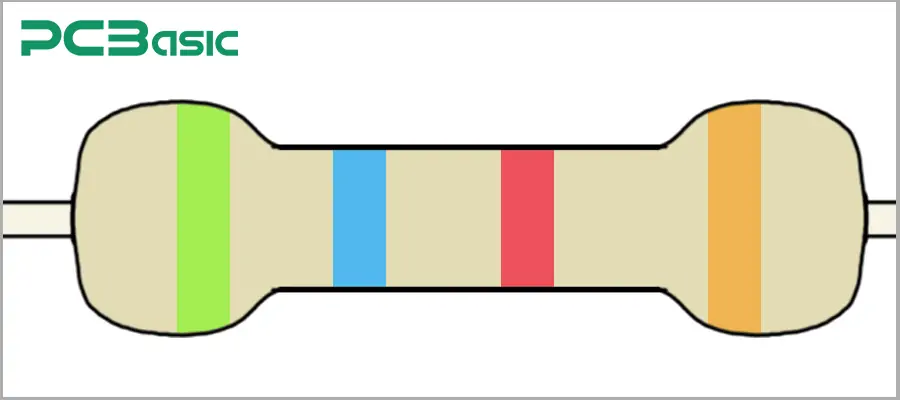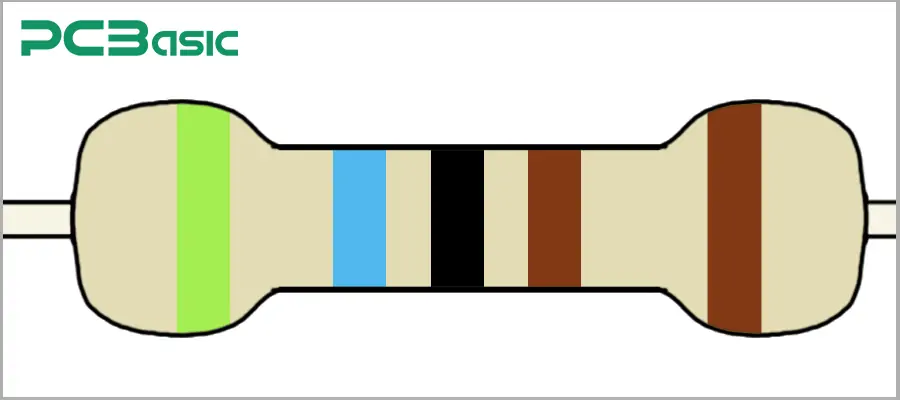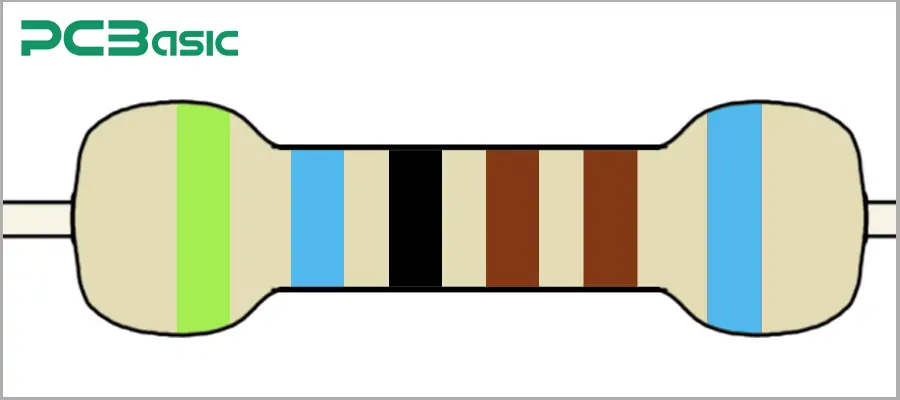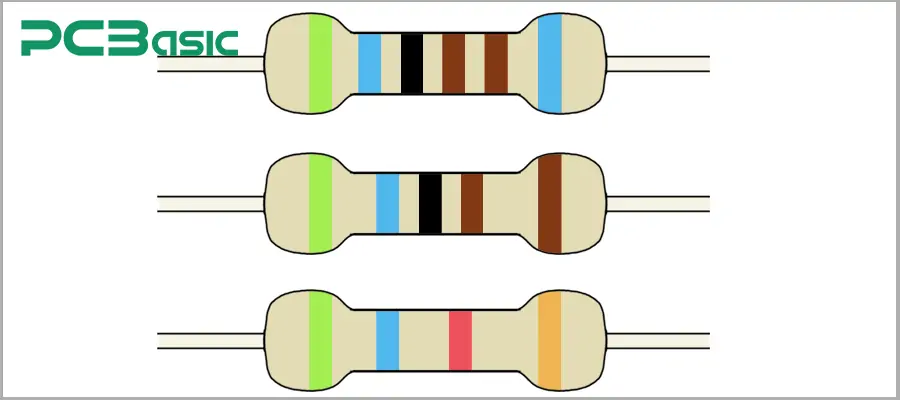Global high-mix volume high-speed PCBA manufacturer
9:00 -18:00, Mon. - Fri. (GMT+8)
9:00 -12:00, Sat. (GMT+8)
(Except Chinese public holidays)
Global high-mix volume high-speed PCBA manufacturer
9:00 -18:00, Mon. - Fri. (GMT+8)
9:00 -12:00, Sat. (GMT+8)
(Except Chinese public holidays)
HomePage > Blog > Knowledge Base > 5.6K Resistor Color Code: A Complete Guide
5.6 k resistor refers to a resistor with a resistance value of 5.6 kilo ohms. Resistors are components used in circuits to limit current, thereby controlling the current size, applying voltage division or current splitting. In the field of electronics, being able to quickly and accurately identify the resistance value of a resistor is crucial for design, assembly and maintenance. However, usually, manufacturers do not directly print the numerical value on each resistor casing, but instead use a standardized resistor color band code to represent the resistance value, tolerance, and sometimes even the temperature coefficient. A 5.6 k resistor is a very common type of resistor, and understanding its color band code is necessary.
While understanding resistor color codes is not just about remembering the numbers corresponding to the colors; it also involves understanding how the numbers, multiplier coefficients, and tolerance bands are combined to represent a resistance value. Today, in this article, we will thoroughly analyze the reading of 5.6 k resistor color codes and related content of 5.6 k resistors. Let's learn more!
It was mentioned earlier that manufacturers do not directly mark the resistance value on the component, but rather use color coding to indicate it. Yes, the color coding of resistors is a standardized color ring identification system. It uses colored bands to indicate the resistance value, tolerance, and sometimes the temperature coefficient as well.

The 5.6K resistor is also written as 5.6K ohm resistor, 5600 ohm resistor, or 5.6 kilo ohm resistor. Its resistor colors (as shown in the figure) are usually green - blue - red to represent the resistance value, followed by a tolerance ring such as gold or silver. This sequence represents "5" (green), "6" (blue), and the multiplier 100 (red), resulting in 5600 ohms.
Next, we will thoroughly analyze the color code of the 5.6K resistor, including its 4-color, 5-color, and 6-color resistor color codes.
When we talk about the 5.6 k resistor color code, we are actually describing a coding method that uses colored bands to represent the resistance value, tolerance, and (in some cases) the temperature coefficient. Different numbers of color bands represent different levels of precision and information. The common representations include 4-color bands, 5-color bands, and 6-color bands. Before understanding the color coding method for 5.6 k resistors, you can first take a look at the following resistor color coding table. (This way, when we explain below, you will know what each color represents.)
|
Color |
Digit |
Multiplier |
Tolerance |
|
Black |
0 |
×1 |
|
|
Brown |
1 |
×10 |
±1% |
|
Red |
2 |
×100 |
±2% |
|
Orange |
3 |
×1,000 |
|
|
Yellow |
4 |
×10,000 |
|
|
Green |
5 |
×100,000 |
±0.5% |
|
Blue |
6 |
×1,000,000 |
±0.25% |
|
Violet |
7 |
×10,000,000 |
±0.1% |
|
Gray |
8 |
×100,000,000 |
±0.05% |
|
White |
9 |
|
|
|
Gold |
|
×0.1 |
±5% |
|
Silver |
|
×0.01 |
±10% |
|
None |
|
|
±20% |
The 4 band color code of resistor is the most common form. This representation method is applicable to most general-purpose resistors. The four-ring color code for a 5.6 k ohm resistor is shown in the following figure.

The first ring is green, representing the number 5;
The second ring is blue, representing the number 6;
The third ring is red, indicating a multiplication factor of ×100;
The fourth ring is the tolerance ring, commonly gold (±5%) or silver (±10%)
(The tolerance indicates the manufacturing error range of the resistor.)
Multiply the first two digits 5 and 6 by the multiplication factor 100, and you will get 5600 ohms (which is 5.6 kΩ). In the figure, the fourth ring is gold, meaning the tolerance of the 5.6 k resistor is ±5%.
The color code of color-resistance components is typically used for high-precision resistors, such as those with a tolerance of ±1% or lower. The first three bands represent the complete three-digit value, the fourth band indicates the multiplier, and the fifth band denotes the tolerance. As shown in the figure,

The 5-band 5.6 k resistor color code is presented as: green (5), blue (6), and black (0). This represents the three significant digits "560". The fourth band, brown, indicates a multiplier of ×10, and the last band, also brown, indicates a tolerance of ±1%. After the calculation, we still obtain 5600 ohms, but this one has higher precision.
The color code of 6-band resistors adds a sixth band to the 5-band system. It represents the temperature coefficient. This index is very important in precision circuit design because temperature variations can cause small changes in the resistance value. As shown in the figure,

This 6-band 5.6 kilo ohm resistor has the same first five bands as the 5-band color code. The sixth band is blue, indicating a temperature coefficient of 10 ppm/℃. This means that for every 1℃ increase in temperature, the resistance value will only change by 0.001%, which is extremely stable.
Whether it is a 4-color ring, a 5-color ring or a 6-color ring, their core calculation principles are all the same. The first few rings represent the significant figures, followed by the multiplier ring, and finally the tolerance ring (and in the 6-color ring, there is also an additional temperature coefficient ring). Mastering these rules, we can quickly identify various values of resistors. Of course, if you are not sure, you can also verify it through the resistor color code calculator or multimeter to ensure that your components meet the design requirements.
Common 5.6K Resistor Color Code Summary Table
|
Type |
Value Bands |
Multiplier Band |
Tolerance Band |
Resistance Description |
Temperature Coefficient Band |
|
4-Band |
Green, Blue |
Red |
Gold |
5.6 kΩ ±5% |
— |
|
4-Band |
Green, Blue |
Red |
Silver |
5.6 kΩ ±10% |
— |
|
5-Band |
Green, Blue, Black |
Brown |
Brown |
5.6 kΩ ±1% |
— |
|
6-Band |
Green, Blue, Black |
Brown |
Brown |
5.6 kΩ ±1%, Temperature Coefficient 10 ppm/℃ |
Blue |
When actually identifying a 5.6K ohm resistor, we can follow these four steps:

Step 1: Determine the starting position of the color bands
First, find the color band closest to the edge of the resistor. This is the starting point for reading the resistor's color code. Then, read the color bands in the fixed order: significant digits → multiplier → tolerance → temperature coefficient (for 6-band resistors). Usually, one end will have a tolerance band (e.g., gold indicates ±5%, silver indicates ±10%), and the tolerance band is generally at the end (Note: The last ring of the 6-color ring represents the temperature coefficient.). We can also determine the starting point based on this: the opposite end of the tolerance band. However, it should be noted that sometimes the colors at both ends may look similar, so it's best to determine the starting point based on distance.
Step 2: Identify the significant figures and the multiplier coefficient.
After determining the reading direction, we can decode the resistor one ring at a time according to the resistor color code chart or a resistor color code calculator. For a 4-band resistor, the first two bands represent the significant digits, the third band is the multiplier, and the fourth band is the tolerance. For a 5-band resistor, there is an additional significant digit, making it more precise. As for a 6-band resistor, the first five bands are the same as those of a 5-band resistor, but the sixth band represents the temperature coefficient, making it even more accurate.
Step 3: Continue to read the tolerance and temperature coefficient.
Step 4: Verify with tools or instruments.
Even if the color bands have been read, it is recommended to use a resistor color code calculator or a multimeter for a second confirmation, especially when the color bands are faded, contaminated, or poorly printed.
1. Reverse Reading: Starting from one end of the tolerance ring leads to completely incorrect resistance values.
Solution: Confirm that there is no tolerance ring at the starting end.

2. Faded or Contaminated Color Bands: Unclear colors result in misreading.
Solution: Observe under strong light or directly measure with a multimeter.
3. Color Confusion: Mistaking brown (1) for red (2) or blue (6) for purple (7).
Solution: Use a magnifying glass or light for observation, and refer to the color code table for comparison if necessary.
4. Ignoring Temperature Coefficient :Ignoring the temperature drift effect in high-precision applications leads to measurement deviations.
Solution: Consider the temperature coefficient during the design stage when selecting components.

5.6K ohm resistors are a very versatile component, widely used in analog, digital, and mixed-signal circuits. Below, we will introduce the four common scenarios where they are frequently used.
Voltage divider circuit
In a voltage divider circuit, the 5.6K resistor is a commonly selected value that can reduce a high input voltage to the desired low voltage, facilitating safe input to sensors, microcontrollers, or analog-to-digital converters (ADCs). Since the voltage divider ratio has certain requirements for resistance accuracy, when selecting and installing, it is necessary to accurately identify the color code of the 5.6K resistor or use a resistance color code calculator for verification to ensure a stable output voltage and compliance with design specifications.
Current limiting of LEDs and other components
The 5.6K ohm resistor is also commonly used as a current-limiting element for LEDs, optocouplers, and small-signal devices. When connected in series in the circuit, it can effectively control the current and prevent the device from being overloaded and burned out.
Pull-up/down resistors in digital circuits
In digital circuits, the 5.6K resistor can be used as a pull-up or pull-down resistor to maintain the stable logic level of the input pin when there is no signal, avoiding abnormal actions caused by floating. The 5.6K resistance value can both reduce static power consumption and ensure reliable identification of logic levels.
RC timing circuits
When the 5.6K resistor is used in combination with a capacitor, an RC timing network can be formed to achieve functions such as delay, filtering, or setting the oscillation frequency. In applications such as mechanical key debounce, the combination of the resistor and the capacitor can smooth the signal and reduce jittery false triggering.
5.6K ohm resistors belong to the standard values of the E12 and E24 resistance series, and they have a large production volume and are widely available. Almost all major manufacturers produce them in large quantities. Not only are they easy to identify, but they also have significant advantages in procurement and application. Thus, they can be easily purchased during both prototype production and mass production, without worrying about long delivery times.
Moreover, they have wide applications. Whether it is for analog signal conditioning, digital logic boards, or mixed-signal systems, 5.6K resistors can operate stably. Their multi-purpose characteristics and ease of verification make them a safe choice for various circuit designs.
5.6K resistors are very common and widely used. They can play a stable role in various applications such as voltage division, current limiting, logic level control, and RC timing. Mastering the reading method of 5.6K resistor color code not only helps in quick selection during the design stage but also effectively avoids misuse during assembly and maintenance. Regardless of whether it is a 4-color ring, 5-color ring, or 6-color ring, the identification principle remains the same. If you want to be more familiar with the reading of resistor color ring codes, you can refer to these articles: 2k, 3.3k, 4.7k, 10k.
 About PCBasic
About PCBasic
Time is money in your projects – and PCBasic gets it. PCBasic is a PCB assembly company that delivers fast, flawless results every time. Our comprehensive PCB assembly services include expert engineering support at every step, ensuring top quality in every board. As a leading PCB assembly manufacturer, we provide a one-stop solution that streamlines your supply chain. Partner with our advanced PCB prototype factory for quick turnarounds and superior results you can trust.

Assembly Enquiry
Instant Quote
Phone contact

+86-755-27218592
In addition, we've prepared a Help Center. We recommend checking it before reaching out, as your question and its answer may already be clearly explained there.
Wechat Support

In addition, we've prepared a Help Center. We recommend checking it before reaching out, as your question and its answer may already be clearly explained there.
WhatsApp Support

In addition, we've prepared a Help Center. We recommend checking it before reaching out, as your question and its answer may already be clearly explained there.
